In the previous installments, we mainly talked about the role of 5-ALA in adding coloring, incremental yield increase and stress growth promotion. In this issue, we will introduce the research and experiment of 5-ALA on postharvest storage of fruit.
1. Materials and methods
The test tomato (Lycopersicon esculentum) variety was sown and raised on August 25,2006, and "Jinpeng exceeded the crown" on October 15,2006. The preharvest experiment was conducted in the Hu family in Yangling Demonstration Area of Shaanxi Province, and the treatment was started after 1 week of planting, and the spray was applied once every other week in the greenhouse of the bottom village. In the experiment, a single factor random block was set up until the time of fruit harvesting, during which a total of 10 times were sprayed. Each treatment planting plan, in the vegetable greenhouse, first delimit the test plot, each plot treatment training management measures are consistent, topdressing with the conventional.
60 plants with an area of about 25 m'. The postharvest experiment was repeated in the College of Horticulture, Northwest A&F University every 3 times after the postharvest treatment, with a total of 6 plots. In the tomato plant growth lab. The fruits were harvested on March 1, 2007, with the color rate of about a long time, when the exogenous ALA provided by COSMO Company of Japan was 80%, and leaf spraying treatment was carried out with uniform color, uniform size and maturity, with spray tap water as the control (CK). The same fruits were harvested in each plot, and the fruits were one replicate. Each time when the light is weak in the evening, the repeated fruit with the back of the leaf wet was about 15 kg. Immediately after harvesting, it was transported back to the experimental level. The amount of ALA sprayed was 0.06 g/m', and 50L of water was added to dilute the chamber and stored in a cold storage at 0~1℃. The spray was applied every 3 days during the whole storage period, and the control spray amount was the same as that of ALA treatment. The tomato was randomly sampled once for the determination of related physiological indexes during cold storage.
2. Results and analysis
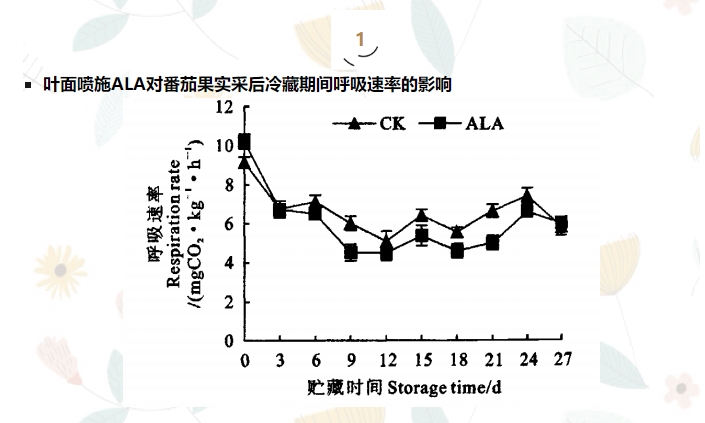
As can be seen from the figure, 5-ALA treatment can effectively inhibit the respiration rate of tomato fruits during low temperature refrigeration (the effect is nearly 30%), thus inhibiting the aging of fruits and playing a role in preservation.
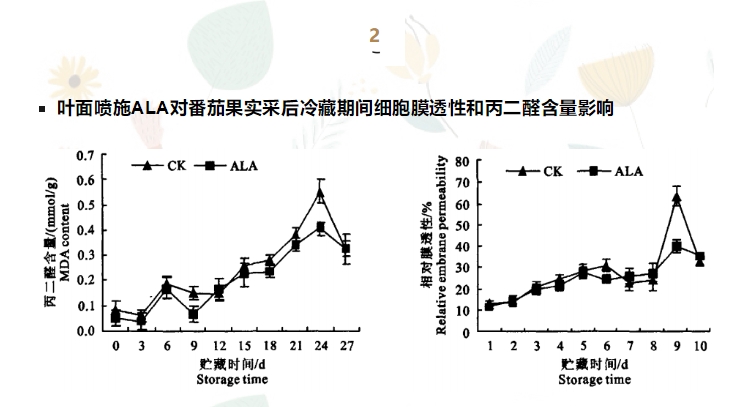
The content of malondialdehyde (MDA) is one of the products of membrane lipid peroxidation, which can affect the structure of cell membrane, and excessive accumulation will cause certain damage to cells.
As can be seen from the figure, the MDA content of tomato fruit treated with 5-ALA is reduced by 25%, which effectively prevents the damage to cells. In addition, the membrane permeability of tomato fruit also decreases and remains stable, thus enhancing the antioxidant capacity of the fruit.
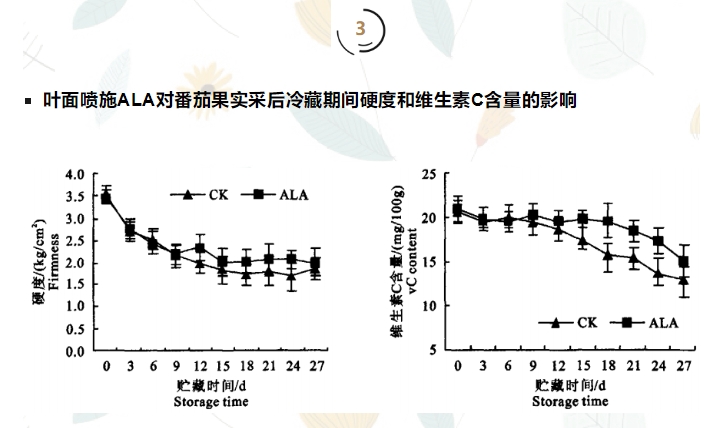
As can be seen from the figure, the fruit hardness of tomatoes treated with 5-ALA decreased slowly, and the hardness was 7.46% higher than that of untreated fruits. At the same time, the loss of vitamin C content was also reduced, and the degree of change was similar to the hardness, and the vitamin C content of tomato fruits treated with 5-ALA was 16.7% higher than that of untreated fruits.
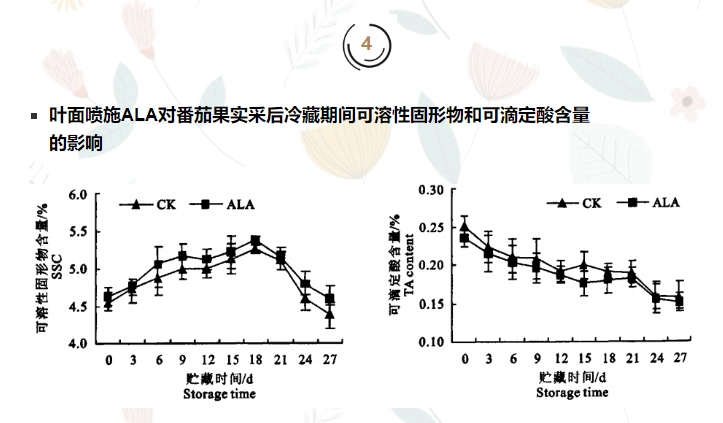
It can be seen from the figure that the solid content of tomato fruit treated with 5-ALA is always higher than that without treatment, with a growth rate of 5.02% and a maximum value of 5.37%. In addition, with the extension of storage time, the titrable acid content in tomato fruits gradually decreased, but the difference was not obvious after the comparison of the two before and after treatment.
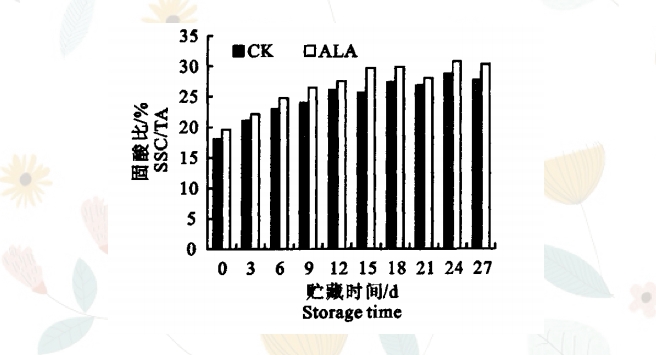
During the ripening process, the content of acid and sugar will change due to respiration and the transformation of substances. When the ratio of sugar to acid is appropriate, the edible quality is the best. As can be seen from the above analysis, the ratio of solid acid in tomato fruits treated with 5-ALA was significantly higher than that in untreated fruits, and the ratio was most obvious at day 15, reaching 29.7%, which was 16.02% higher than that in control group.
In this period, the effects of 5-ALA (5-ALA) sprayed on the leaf surface before harvest on several physiological indexes of tomato fruits during the post-harvest cold storage were studied. The results show that:
Pretreatment with 5-ALA did not affect the respiration rate of tomato fruits during postharvest storage, but decreased the respiration value.
5-ALA treatment can reduce the content of malondialdehyde (MDA) and relative membrane permeability, and delay the decline time of fruit hardness and vitamin C content in the late refrigerated period.
During the whole refrigeration process, the 5-ALA treated fruit family maintained high soluble solid content, its acidity decreased, and the solid acid ratio of fruit increased.